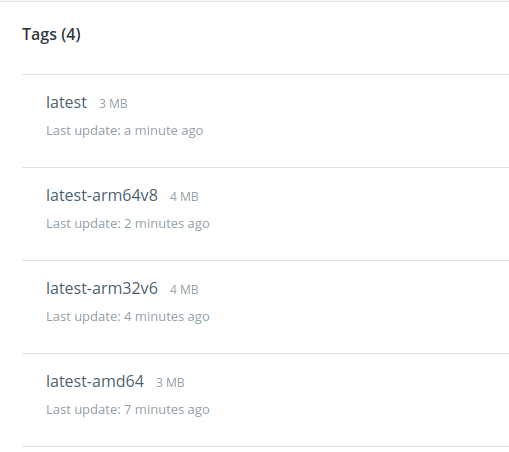This repo provides an example of a multi-arch docker image created from a github repo with dockerhub automated-builds.
Fork this repo. Configure your dockerhub repo automated build pointing to your fork and with the following Build Rules:
Trigger all the image variants. Your dockerhub repo should have now 4 tags (latest-amd64, latest-arm64v8, latest-arm32v6 and latest):
And must be identifed as a multi-arch image in Dockerhub search results:
scripts at hooks/ folder are designed to work with dockerhub automated-build. If you want to try the build phases locally follow next steps:
We need qemu to build with target architecture different from host architecture. hooks/post_checkout download the qemu handle for the Dockerfile.arch architecture.
DOCKERFILE_PATH=Dockerfile.arm32v6 ./hooks/post_checkout
DOCKERFILE_PATH=Dockerfile.arm64v8 ./hooks/post_checkout
For DOCKERFILE_PATH=Dockerfile makes nothing.
qemu interpreter must be set in docker. hooks/pre_build register all qemu handlers as binfmt interpreter in docker.
Just Downloading and registering qemu handlers:
DOCKERFILE_PATH=Dockerfile.arm32v6 ./hooks/pre_build
DOCKERFILE_PATH=Dockerfile.arm64v8 ./hooks/pre_build
For DOCKERFILE_PATH=Dockerfile makes nothing.
docker build -f Dockerfile -t hello:latest-amd64 .
docker build -f Dockerfile.arm32v6 -t hello:latest-arm32v6 .
docker build -f Dockerfile.arm64v8 -t hello:latest-arm64v8 .
You can verify image corresponde to the target architecture:
docker run --rm hello:latest-arm64v8
hello from a aarch64 machine!
A multiarch image manifest is important to let docker transparently pull the image corresponding to the host architecture.
hooks/post_push first checks if all architecture images exists in dockerhub repo. Then it create the multiarch image manifest and push it to dockerhub. To do that, it must download docker-cli v18.06+ BUG-Ref, enable the experimental manifest subcommand and docker login to dockerhub repo.
To build the manifest local just use docker-cli v18.06+ in your host and enable experimental manifest subcommand adding "experimental":"enabled" to your ~./docker/config.json. Then you can run:
docker manifest create hello:latest hello:latest-amd64 hello:latest-arm32v6 hello:latest-arm64v8
docker manifest annotate hello:latest hello:latest-arm32v6 --os linux --arch arm
docker manifest annotate hello:latest hello:latest-arm64v8 --os linux --arch arm64
docker-cli provides a command to update the multiarch manifest to dockerhub with:
docker manifest push hello:latest
References:


